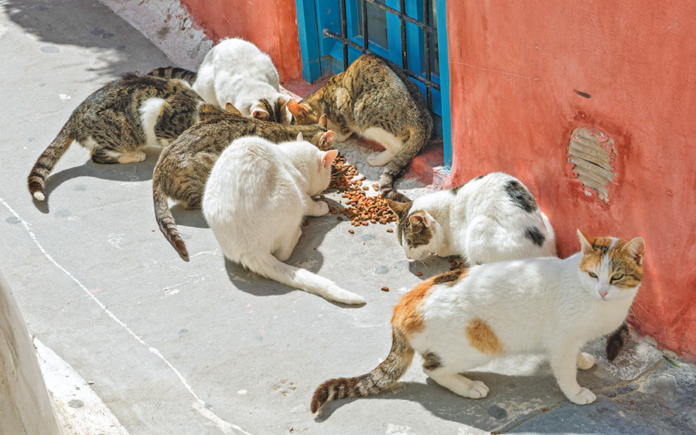Stray cats are an issue that has challenged communities for a long time and does not have a simple solution. Although controversial, trap-neuter-return (TNR) programs are one of the most common current methods used to help address the issue of unowned cat populations, particularly feral cats who are not suitable for being placed in homes.
Also sometimes referred to as shelter-neuter-release (SNR) or return-to-field (RTF), the basic theory of TNR is simple: Trap as many stray cats as possible, spay and neuter them, offer other medical care when possible, and then return them to where they came from. The goal is to reduce the number of intact cats and thereby limit reproduction and population growth.
Why Stray Cats Are an Issue
Free-roaming cats can be a nuisance to people by making noise and damaging property and are a significant threat to wildlife, such as birds and small mammals. These cats can also spread diseases and parasites to both owned cats and to humans. The larger the population of unowned cats, the greater the risk of disease and other problems. Feral and stray cats are also exposed to the hazards of weather, larger predators, and cars.
Solving the Problem
Accountability is part of the challenge—who is responsible for dealing with stray cats? “In most places, there is no governmental entity responsible for taking the lead on cat populations,” says Lena DeTar, DVM, DACVPM, DABVP-SMP, Assistant Clinical Professor in Maddie’s Shelter Medicine Program at Cornell University College of Veterinary Medicine. Instead, different groups or individuals get involved in different areas.
“When wildlife is impacted by feral or stray cat populations, the department of natural resources may get involved. When stray or feral cats are ill, county or municipal animal control may be asked to collect the animal. In most jurisdictions, non-governmental organizations, such as humane societies, SPCAs, non-profit clinics or special interest groups help respond to concerns about feral cats. Motivations can vary from concern about impacts on wildlife and birds, public health, or feline welfare (or all of the above),” says Dr. DeTar.
Realistic Goals
“The enormity of the feral cat problem is such that neither TNR nor Trap/Euthanize programs can possibly ‘solve’ the problem on a national scale; estimates range from 30-80 million feral cats currently living in the U.S., which far exceeds our surgical or euthanasia capacity,” says Dr. DeTar.
Research has shown that in order to get a significant reduction in population, at least 75% of the cat population must be sterilized or at least 50% of the population must be euthanized. With 30 to 80 million unowned cats out there, you are looking at sterilizing 22.5 to 60 million cats or euthanizing 15 to 40 million cats. These are staggering numbers, with staggering costs to implement. “Trapping cats is intensive, difficult work,” says Dr. DeTar, “and if new cats are attracted or added to the un-fixed outdoor cat population, trapping efforts must continue on an intensive and regular basis.”
But there is hope. “Within our communities, however, specific, pro-active targeting of colonies/areas producing the largest numbers of kittens for TNR is quite impactful on local population reduction and shelter intake,” Dr. DeTar says.
A study published in the February 2016 Journal of the American Veterinary Medical Association looked at the intake and euthanasia rates for cats at an animal shelter in Northern California over the four years before and after the shelter initiated a SNR program modified to fit their needs.
After starting the program, the number of cats admitted to the shelter each year decreased and their euthanasia rate decreased (the latter being because feral cats that previously would have been euthanized for being unadoptable were instead returned to their territories). With fewer cats in the shelter, those cats were able to be adopted more quickly.
This is, of course, just one study in one location, and it covers a relatively short period of time. But it shows that a positive impact can be made when a community makes a plan that works for their area and is able to dedicate adequate resources to enact it.
Multimodal Approach
“TNR is not functional on its own to regulate feral cat and stray cat numbers in terms of feline population across large areas, but may work well for preventing population expansion in small communities,” says Dr. DeTar. “When combined with other efforts, such as rehoming friendly cats through adoption, removal of ill cats through euthanasia, and relocation of feeding stations away from sensitive areas/wildlife, TNR becomes a much more successful and sustainable method for responsible feral cat population management.”
Education also must play a role in controlling unowned cat populations. Many people get cats on impulse or by accident (we’ve all heard stories of cats who chose their owners rather than the other way around) without people thinking through the responsibilities that come with cat ownership.
Cat owners and prospective owners should be educated about spaying and neutering cats not intended for breeding, keeping cats indoors or on a leash to prevent harm to wildlife (and prevent roaming and unwanted litters in intact cats), and the basics of good cat care and management.
Microchipping cats is highly encouraged, so that if a cat does get loose and is picked up by someone it can be scanned and reunited with the owner rather than taking up space in a shelter. We also need to encourage a cultural shift away from the current all-too-common mentality that cats are disposable pets that can just be dumped on the side of the road when no longer wanted.
How You Can Help
“Getting involved with local or national organizations providing services [for unowned cats], giving money, or volunteering in the field are all ways that the public can get involved,” says Dr. DeTar. “Other ways to help include lobbying for reasonable ordinances regarding outdoor cat welfare, and fostering the kittens of feral moms so they become friendly and adoptable. Finally, responsible pet ownership, spaying/neutering their own cats, and adopting spayed/neutered cats from shelters can actually go a long way to decrease outdoor cat populations.
For those looking to get even more deeply involved, organizations like Alley Cat Allies have a lot of resources and experience starting feral cat management projects.” For more information on Alley Cat Allies, check out their website at www.alleycat.org.
Looking Forward
Trap-neuter-release is not a perfect solution to the feral cat problem, but with sufficient funding and when combined with other methods of colony management it can help to reduce population numbers and minimize the impact on wildlife.
“TNR is a good interim solution for balancing feline and wildlife welfare, since we know that these cats DO NOT belong in a shelter, nor do we support killing them on sight,” says Dr. DeTar. “Future research into non-surgical sterilization methods for cats and more research/proactive action on minimizing impacts of cats (and humans) on wildlife are on-going. We look forward to exciting innovations in the years to come.”
To Feed or Not to Feed?
Feeding feral and stray cats is a controversial topic
“More studies are needed to assess the true impacts of feeding stray and feral cats and its impact on both cat populations and wildlife,” says Dr. DeTar, but there are some guidelines to use. If you are feeding one or more stray cats, some good habits to minimize problems include only setting the food out for a limited time (i.e., half an hour a day) and cleaning bowls between feedings. Keep track of how much food is eaten to avoid putting out too much food, which would attract more cats and other animals to the feeding station. If feeding cats in preparation for trapping, feed at the same time of day to get the cats in a routine, and place the food in unset traps for a couple days to allow them to acclimate to the traps (thereby maximizing the number of cats that you will be able to trap). Be aware, too, that there may be local ordinances that would prohibit you from feeding feral cats.

Cats and Wildlife
Cats like to hunt, and will do so whether or not they are well fed by loving owners. To protect wildlife, keep your pet cat indoors unless on a leash and harness. You can also build an enclosed catio for your cat to enjoy fresh air and sunshine without terrorizing local birds.
While you’re at it, support wildlife in other areas of your life too. Donate to groups that manage or lobby for natural areas, and respect the rules when visiting parks and sanctuaries.
You Trapped a Feral Cat! Now What?
The challenge of catching the cat is a small part of the battle
If you have some unowned cats in your area, be they new cats hanging out in your garage or an established colony in the neighboring business park, start by making a plan. Talk to other people who are interested or invested in the cats to make sure everyone is on the same page, and know where you are going to take the cats once you successfully trap them. Do you have enough traps for all of the cats? Are you taking the cats to the veterinarian you use for your pets, or are you utilizing a low-cost spay/neuter clinic? What is their schedule, and can they accommodate the number of cats you are bringing along? Will you also be vaccinating the cats or seeking other care measures such as ear cleaning, disease testing, or treatment for minor injuries? Who is paying the bill?
“Communication regarding surgery is essential, and not every organization performs procedures every day,” warns Dr. DeTar. “Before trapping, citizens should be in contact with the shelter or veterinarian providing these services regarding protocol and timing. Spay/neuter surgery for trapped cats is a generally safe and straightforward process, but veterinarians or their staff should discuss surgical risks and contingency plans with trappers, including when euthanasia will be recommended (FIV/FeLV status, ill health, if a bite occurs, etc.).” The surgeon will use absorbable suture so that the cat will not need to come back for a suture removal appointment.
Also be sure to ask the veterinarian to remove the tip of an ear on each cat to indicate that they have been spayed or neutered. While not the most elegant solution, ear tipping has minimal complications and saves cats from undergoing an unnecessary second surgery if they are later trapped by a different person. If you happen to trap a cat with a tipped ear, you can release him or her right away.
“Finally, a plan should be discussed for when the cats will be fed and/or released from their traps,” says Dr. DeTar. “Usually keeping the cats in their traps indoors overnight in a quiet place is recommended, with release the day after surgery. Since cats acclimate well to outside weather, TNR can be performed any time of year.”




